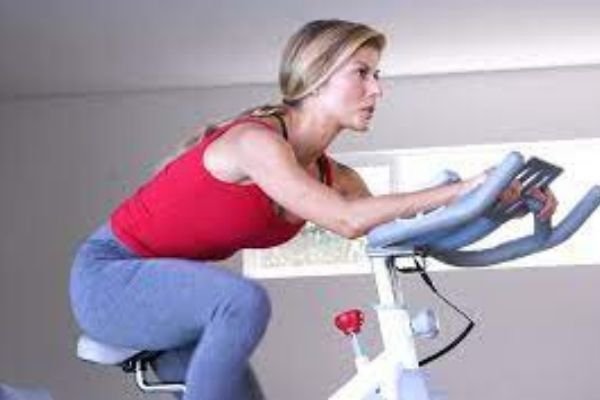Indoor Cycle Training for Winter Cycle Fitness

Winter Indoor Cycling Training, Use Spinning Bike or Bike Trainer
Cycle training outdoors can be hard in the depths of winter. Consider an indoor cycling training program using a bike trainer with your bike or a spinning exercise bike.
Even ultra keen road cyclists and mountain bikers find it hard to keep riding outdoors when winter sets in, the wind starts to blow, and temperatures drop to near or below freezing. While the right set of winter cycle clothing can help keep the elements at bay, cycle fitness inevitably suffers when rides get shorter, purely as it’s just too cold to stay outside that long.
Professional cyclists head for warmer climates for winter training. Still, keen club cyclists often resort to indoor cycle training using their bicycle on a bike trainer or a stationary spin bike. This article looks at the costs and advantages of both methods used by both road cyclists and mountain bikers to maintain fitness over winter.
Spinning Bike Home Exercise Cycle
Spinning is one of the most influential fitness classes at any gym, burning calories and offering a personal challenge to participants. The spin bike itself mirrors outdoor cycling far better than most other stationary exercise cycles as riders lean forward to power up hills and flick a switch on the handlebars to “change gear” just as they would on a regular bicycle.
Spin bikes are not cheap as a reasonable quality model costs between $500 and $600, but many cyclists prefer them for indoor training rather than wearing out their regular bike using a bike trainer. Unlike traditional exercise cycles, spin bikes do generally not have a performance monitor, just a simple lever on or underneath the handlebars to adjust wheel tension and make riding harder or easier.
Magnetic Bike Trainer
A cheaper alternative to a spin bike is to buy a magnetic bike trainer who is effectively a stand with a raised locking mechanism for the back wheel.
Resistance is provided either by an easy-to-adjust magnetic unit or, in more expensive cycle trainers, via a fluid-filled team. The front wheel is generally raised off the ground using a riser block, so, with the bike nicely balanced and locked in at the back, a cyclist can pedal away and focus on improving technique on his trusty steed.
Bike trainers start from around $200, rising to well over $600 for the latest fluid trainers with rollers. Bear in mind that bike parts will wear just as quickly when used indoors, and tires may need frequently replacing due to the friction caused by using an indoor trainer. However, a cycle trainer is compact and easy to store, plus easy to put in a car to use for a warm-up on race days.
Maintain Cycle Fitness
Indoor cycle training on a stationary bike can feel much more challenging than riding outdoors because a steady pace must be maintained to keep the wheel turning. There is no opportunity to freewheel on flat sections. For that reason, a spin bike may be preferable as the resistance knob on the bike can “change gear” to make it feel like you are cycling downhill.
It is also advisable to incorporate some form of strength training to maintain cycle fitness during the winter months, either by using free weights or by combining stationary cycling with another form of cardiovascular fitness, such as indoor rowing. Round off the fitness regime with yoga stretches to maintain flexibility.
Winter Training for Cyclists with a Stationary Bike
Maintain cycle fitness this winter using a stationary bike, either a spinning bike or a regular bike locked into a cycle trainer. The budget will largely determine which method to choose, bike trainers, cheaper but frequent bike part replacement offsetting the higher cost of a spin bike.





